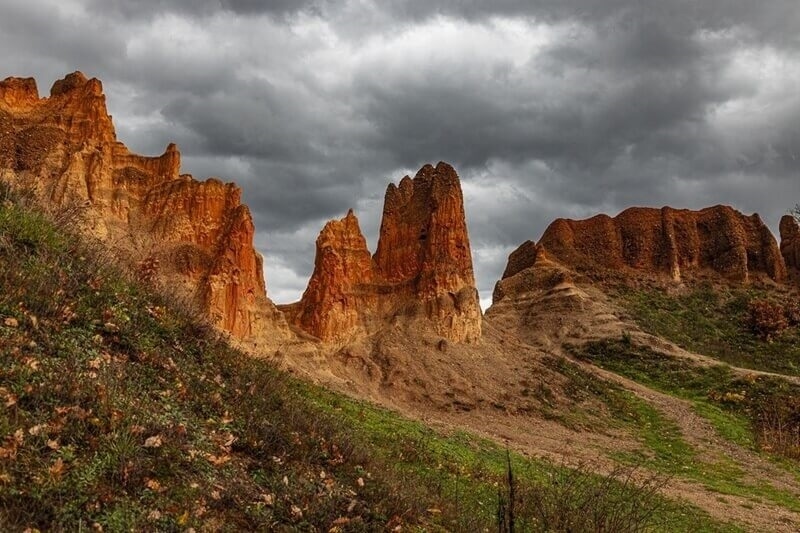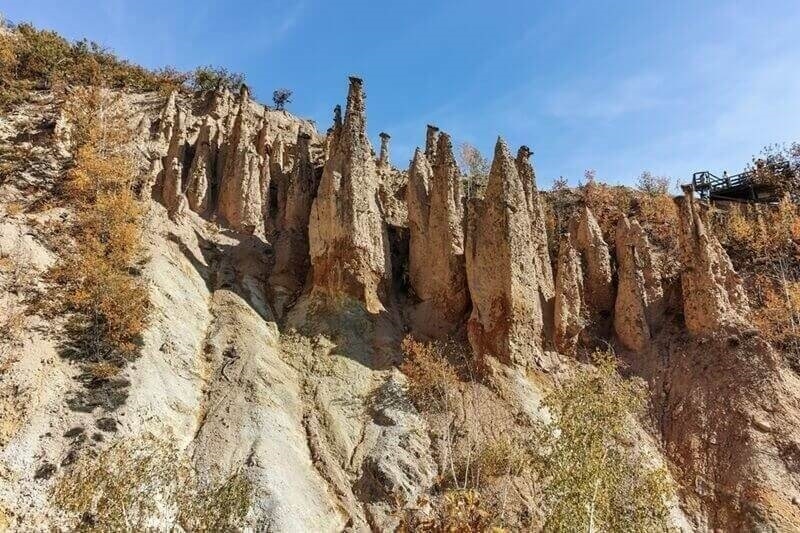
It’s not a place you stumble into. It’s a place you hear about, secondhand—whispered over campfires, passed through blog comments, half-joked about by locals who won’t meet your eyes when they say the name: Devil Town.
Hidden deep in southern Serbia, near the Radan Mountain, this haunting spot—also called Devil’s Town or Devils Town—looks like something scraped out of a fever dream. 200+ earth pillars shoot up from the ground like crooked teeth, each capped with boulders that shouldn’t be there, but are. The terrain? Rough. The air? Heavy. The silence? Loud.
But what is Devil Town about, really? And why does it leave such a mark on everyone who visits?
Let’s dig in.

First, the basics—this isn’t just eerie for the sake of it. Devil Town is a wild geological phenomenon that happened because nature had a meltdown and left the scars behind.
Millions of years ago, a volcano blew through the area, leaving behind layers of soft volcanic sediment. Over time, rain and wind eroded those layers. Wherever a heavy rock sat on top? That part was protected. Everything else around it got scraped away. What’s left are massive stone “towers” that look handmade but are 100% nature’s doing.
Some pillars stretch up to 50 feet. Some look like cloaked figures. Others lean, ready to fall but never quite do.
And the weirdest part? The landscape isn’t done. It’s changing all the time. Some formations collapse, others rise. It’s alive in that silent, slow-breathing kind of way.
So if someone asks what is Devil Town about, tell them this: it's what happens when nature loses its temper and then paints a masterpiece with the aftermath.
Don’t Miss: What are 7 Wonders of the World? Ancient to Modern Explained
Let’s get something straight. This is not a tourist trap dressed up for Instagram. The paths are rough. The incline is real. The dust clings. You’ll sweat. You’ll slide. You’ll question your footwear.
That’s why some travelers nickname it the dirty devil town—not as an insult, but as a nod to its raw, untouched energy. You’re not strolling through a park. You’re walking through a place that feels like it could swallow you if it wanted.
The trail is about 850 meters, but the elevation hits fast. The soil’s dry and ochre-red, the kind that stains shoes and gets under your nails. Don’t expect guardrails or fancy signs—this isn’t Disneyland. It’s Devil’s land.
Still, people come. Not for comfort, but for something older. Something real.
This is Serbia. Of course, there’s a story—or five.
The most told tale? A wedding that should’ve never happened—between a brother and sister. The Devil, furious, decided to crash the party and turned the entire wedding procession into stone. The bride. The groom. The guests. All frozen mid-celebration, now standing as those pillars.
That’s Devil’s Town. Or as locals sometimes call it, Đavolja Varoš—the devil’s town.
Another legend says a witch lived in these hills, offering favors in exchange for secrets. One wrong move, one broken promise, and she’d curse you. Your punishment? Eternity beneath a stone tower.
Visitors say the wind makes strange sounds here. Whispers. Murmurs. Some think it’s just air whistling between the formations. Others aren’t so sure. When the sun dips low and the rocks cast long shadows, it’s easy to believe that something—or someone—is still watching.
Folklore or fact, these stories give Devil Town a presence you can’t ignore. The pillars don’t just look like people. They feel like people.
Near the base of the formations, you’ll find two springs—one bubbling with acid, the other bleeding iron.
These aren’t just pretty side attractions. They add weight to the legends. Heat. Sound. Smell. Devil Town doesn’t just look strange—it feels alive.
Not far from the main trail, tucked among trees, stands a tiny wooden chapel: the Church of St. Petka. It doesn’t look like much—but it carries centuries of quiet faith.
Locals believe the waters near this church have healing powers. They’ll dip cloth strips into the spring, make a wish or prayer, and tie them to a nearby tree. After seven days, the cloth is buried. Whatever pain it held? Supposedly buried with it.
This strange ritual adds another layer to what Devil Town is about—not just nature and myth, but belief. Even here, where the Devil's said to roam, people still whisper prayers to saints.
Location: About 30 km southeast of Kuršumlija, 90 km from Niš, and roughly 290 km south of Belgrade.
Getting there: Drive. No buses go all the way in. The road gets rough near the end, so prepare for tight turns and steep hills.
Entry fee: 350 dinars (~$3 USD)
Trail length: ~850 meters, uphill.
Facilities: There’s a basic restaurant, a souvenir kiosk, and not much else. Bring water, especially in summer.
Best time to visit: Spring or fall. Avoid summer heat and crowds—especially school tours that roll in by the dozens.
You’d think a place like Devils Town would’ve been plastered all over travel reels by now, overrun with tourists. But it hasn’t. And that’s part of the magic.
There’s no glam. No filters. Just dust, wind, rock, and myth.
Back in 2009, Serbia nominated Devil’s Town for the New 7 Wonders of Nature. It didn’t make the final cut—but the nod meant something. It proved what locals already knew: that this strange little corner of the world punches way above its size.
And if you think it’s just about rocks, think again. Devil Town is about time. Memory. Superstition. It’s a dirty devil town that gets under your skin because it doesn’t just stand there—it watches.
Some call it “creepy.” Others say it’s “beautiful in a way you can’t photograph.” A few say they felt like they weren’t alone.
That’s the thing about Devil Town. It lingers. You walk in expecting weird geology. You leave wondering why the wind sounded like it was whispering your name.
Redditors have called it “weirdly humbling” and “low-key terrifying.” Not because anything happens—but because something could.
And maybe that’s the point.
You may also like: Haleakala tours: A Natural Wonder and Top Tour Experiences
If you want polished trails and gift shops, skip this one.
But if you want to stand in a place where time cracked open the earth, where myths grew out of the dust, and where the silence isn’t really silent—Devil Town is calling.
It won’t beg for attention. It doesn’t care if you’re impressed. It’s not here for likes. But if you pay attention, the rocks will whisper. Maybe not in words. But you’ll hear them.
And you’ll leave knowing something you didn’t before.
Even if you’re not sure what it is.
This content was created by AI